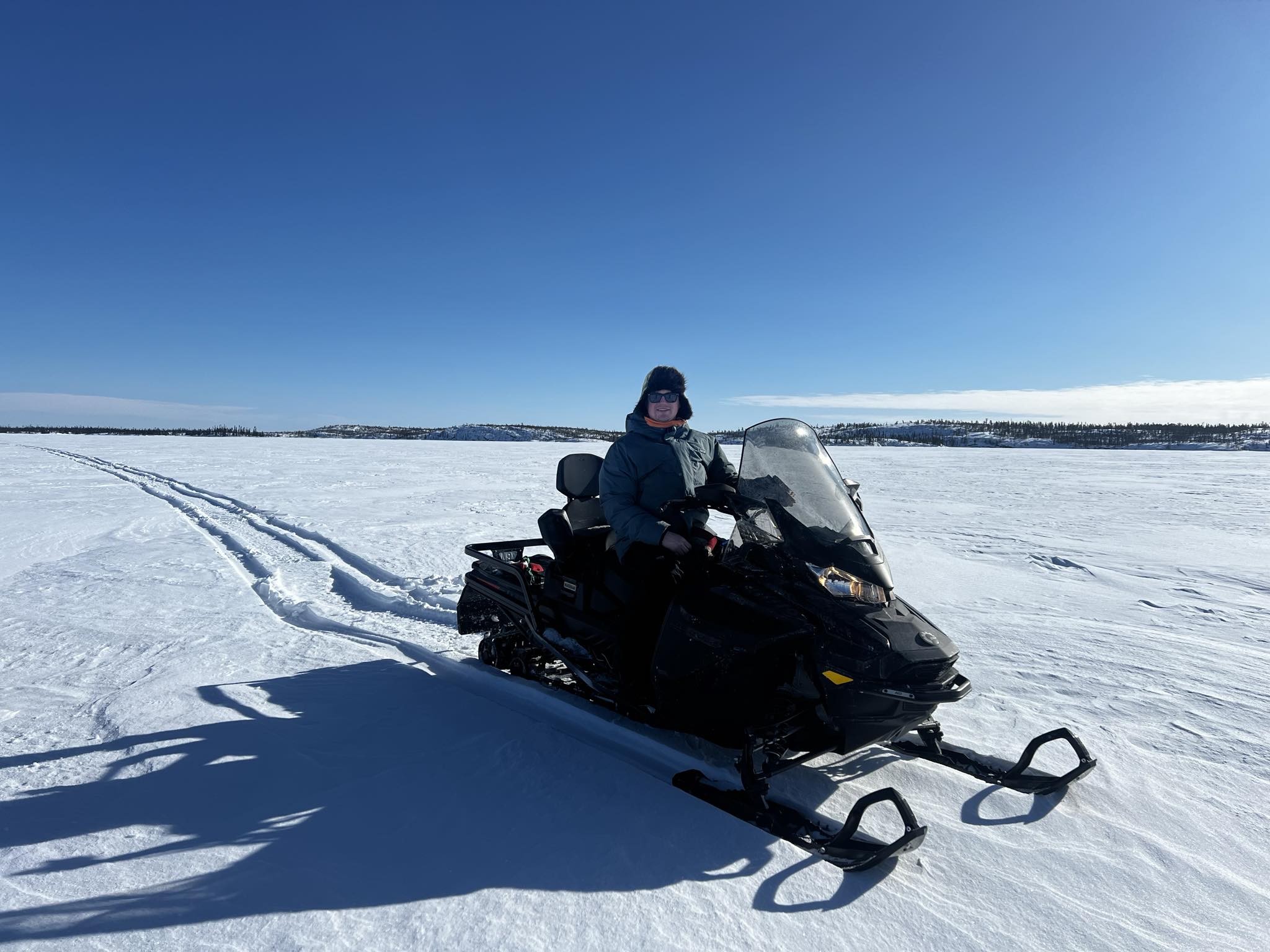30 projects have received funding this year to investigate and monitor how the territory’s caribou, fish and water are affected by environmental changes over time.
Among these projects, seven are guided by traditional knowledge and work closely with Indigenous governments, stakeholders and community members.
The Winter Road Monitoring Program is one of the traditional knowledge-focused programs and was created to address concerns for the North Slave Métis Alliance (NSMA) community. This project monitors data of Barren-ground caribou along the Tibbitt-to-Contwoyto winter road, a major migration route for the Bathurst herd.

Herd of caribou on the Tibbitt to Contwoyto Winter Road. Photo by Winter Road Co-ordinator and NSMA member Wayne Mercredi. (Photo courtesy of Orna Phelan)
“Roads are known to cause various impacts to caribou. Sometimes they can act as a physical barrier and stop caribou physically moving across them, and sometimes it’s the noise pollution and traffic,” says Orna Phelan, a wildlife biologist from the project team.
Their project takes a two-fold approach to monitor caribou’s movement along the winter road. From the scientific aspect, remote cameras and ARUs (Autonomous Recording Units) are used to take images and record soundscapes when caribou pass by.
From the traditional knowledge side, guardian patrols and camps are set up along the road for a more holistic measurement of the caribou, such as their health metrics, injuries, and instances of carcasses and wastage.
“Guardians are the watchers of the land. Indigenous people know the land better than anybody else up here, so it’s empowering to be able to carry out this work themselves,” says Phelan. “It’s guardian-led and guardian-driven.”

NSMA member Kyle Coumont doing caribou patrols on the Tibbitt to Contwoyto Winter Road. (Photo courtesy of Orna Phelan)
The team also held workshops for NSMA members to share their relationships with caribou and how the decline of the Bathurst herd has affected their lives. Phelan shares a quote from one of the members they spoke with:
“As a Métis person and lifelong hunter, I know that we Indigenous people have strong ties to caribou. We are spiritually, emotionally, economically and nutritionally associated with caribou, and have a high degree of cultural dependence on them in our northern lifestyle. They are truly loved.”
Phelan says many members witnessed the decline of caribou over the years, from seeing thousands and thousands of caribou across Prelude Lake to just a few hundred.
The project is currently in the second year of its three-year period, and they are working on gathering and processing the data before sharing results with community members.
“It’s not just because NSMA members really care about the caribou, they’re the ones who wanted this project and they’re the ones who are making it work,” says Phelan. “Once we have something solid, we’ll give a presentation to tell community members about the work they’ve done.”
Phelan’s project goes hand in hand with another funded project that documents the NSMA member’s experiences, perspectives and knowledge of environmental changes and develops a traditional knowledge database for future generations.
The project is called Understanding the Past and Planning for the Future.
“We’ve talked a lot about climate change and how our community has been impacted by changes in the north, but we’ve never actually documented these changes from a Métis perspective,” says Jessica Smart, the NSMA Lands and Culture Department Manager and the file lead for this project.

Orna Phelan listening to the stories of Shirley Coumont (Elder, right) and Darryl Bohnet (Guardian, middle). (Photo courtesy of Jessica Smart)
“A traditional knowledge database is going to ensure that the Métis are adequately heard and represented in decision-making related to big topics like environmental impact assessments, recourse projects and wildlife management.”
Smart adds that they’ve only received funding for one year for this three-year project.
“We’ve been wanting to do this project for so many years, but we’re a small Métis nonprofit government organization where we don’t get funding from the territorial and federal government to run these types of programs regularly,” says Smart.
The NWT Cumulative Impact Monitoring Program provides annual funding between $70,000 to $100,000 per year for three years. The application deadlines for the 2025 funding are October 10, 2024, for the Letter of Intent and January 9, 2025, for proposals.





